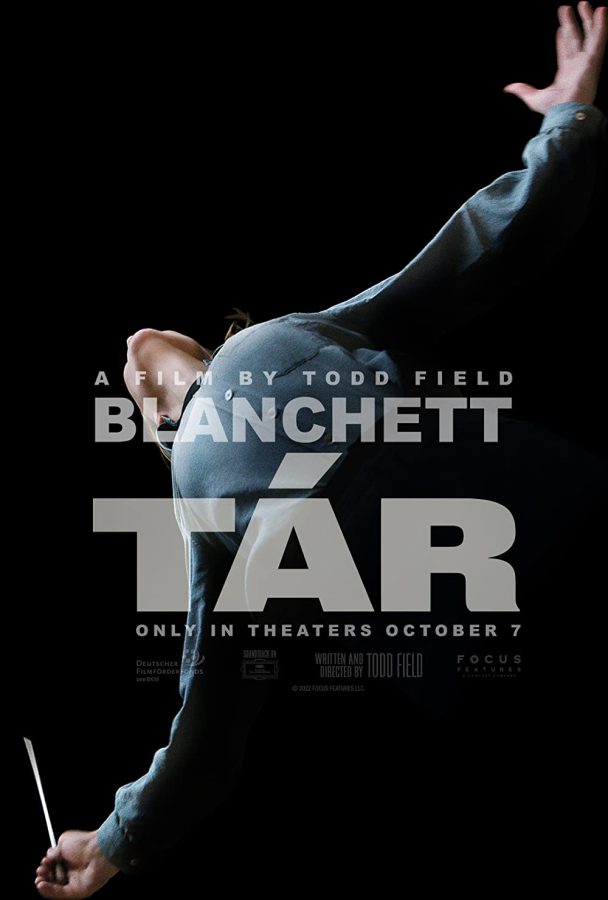‘Tár’ Review: A Long, Slow Masterpiece!
October 26, 2022
Tár is the latest film from director Todd Field. The film is about Lydia Tár, a fictional famous conductor held in high esteem in the world of modern classical music, expertly portrayed by veteran actress Cate Blanchett. The film’s opening scenes portray Tár as a powerful, cold, and emotionless Maestra whose humanity is suppressed by her title. A specific scene toward the beginning of the film in which she teaches a class at Juilliard showcases not only the pedestal she puts herself on but also the reputation she has, striking fear into one specific student who she berates. Tár continues her reign by trying to replace a very experienced conductor with her assistant. At this point, she is at her peak, until she receives news that one of her pupils, Krista Taylor, has committed suicide. This starts a downward spiral in the psyche of Tár, as clues in the narrative start to unravel the perfect picture of Lydia Tár, and various hallucinatory sequences start to invoke paranoia in the viewer, the same paranoia that Blanchett perfectly infuses into the character. As revelations arise, the film becomes a ticking bomb that explodes in the climax, and whose effects can be felt in the film’s somber final moments.
Cate Blanchett is the star of the show, as many at my screening pointed out. Her transformation from the calm, cold Tár seen at the beginning to the shell of herself that she becomes is not only very realistic but wholly riveting. Although the character goes through very strong emotions, Blanchett is able to make us believe that this person is breaking down by refraining from overacting and keeping her performance very understated. Blanchett showcases masterful physical acting with facial expressions that are subtle, yet powerful. The cherry on top is her very convincing piano playing and her delivery of the German dialogue used sparsely in the film. Other great performances are those of Noémie Merlant as Francesca, Tár’s assistant, and Sophie Kauer as Olga, the orchestra’s cellist. Overall, the acting is one of the film’s biggest strengths.
The cinematography is easily the best I’ve seen so far this decade. Every shot is perfectly framed to correspond with the mental state of Tàr. The beginning features many steadily blocked (and visually stunning) shots, with handheld camerawork being used more in tenser scenes in the middle and end. The camera work is another one of the film’s biggest strengths, with the aforementioned Juilliard scene having particularly stunning camera work, all featured in one unbroken shot. The cinematography goes hand-in-hand with the film’s extremely drab lighting and color palette.
An interesting aspect of the film is that it is scoreless, save for rehearsal or similar scenes. Even with the film’s tense and heavy moments, there is no music. To me, this was a genius directorial decision. The lack of score removes the feeling that you are watching a film and makes you feel that you are watching real events unfold before your eyes. This makes the many difficult-to-watch scenes all the more impactful. While I’m on the subject of music, the classical music selected for this film is brilliant, and all the musical aspects were very well executed. Another strength this film has is its sound mixing, with orchestra sounds booming and knocks on doors sounding like battering rams, all increasing the unease and tension.
I hail this film as a modern masterpiece, and it is by far the best I’ve ever seen in a theater. However, while I do classify this film as a masterpiece, my flaws with the film are most likely the same aspects that would drive away any casual viewer from seeing it. My biggest flaw is the film’s length. It is approximately 160 minutes long and can be felt toward the middle of the film. I also think the film could benefit from having a bit less setup, as it takes up a large portion of the beginning, and doesn’t help the already relatively slow pace. Naturally, for a film geared toward more of an arthouse crowd, multiple sequences make this film much less accessible to people who simply watch films for entertainment. If you are not turned away by long runtimes, slower paces, or metaphorical sequences, then I urge you to support the Avon Theatre Film Center and watch this film at one of their screenings. If you are turned away, then I would recommend you skip it.





ALLSTAR Phat • Oct 27, 2022 at 1:09 pm
Greatest review ever?